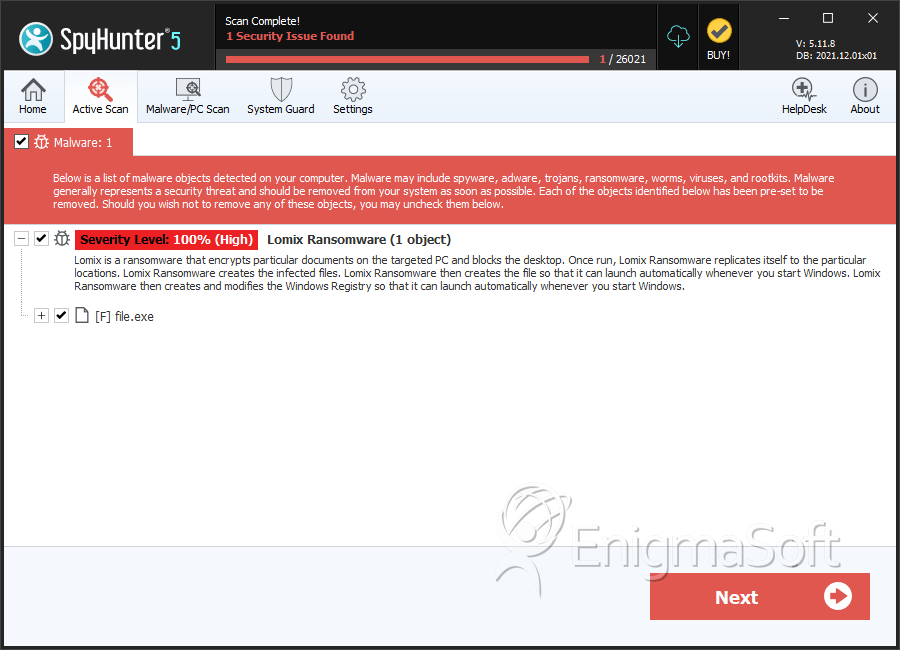Lomix Ransomware
The Lomix Ransomware is a ransomware infection that is used to make money at the expense of computer users. The Lomix Ransomware is a variant of CryptoWire, a known open source ransomware engine. If the Lomix Ransomware has infected your computer, PC security analysts advise against paying the ransom the people responsible for this attack demand.
Table of Contents
A Pop-Up Window Displays the Lomix Ransomware Ransom Note
The Lomix Ransomware is an encryption ransomware Trojan. Like most threats of this type, the Lomix Ransomware carries out its attack by encrypting the victim's files and then demanding the payment of a ransom in exchange for the decryption key needed to restore the affected files. The Lomix Ransomware encrypts files using an advanced encryption method, an AES-256 encryption algorithm coupled with the RSA decryption. The files encrypted by the Lomix Ransomware can be identified because the Lomix Ransomware adds the string '.encrypted' to the end of the file name, following the naming convention '[file_name].encrypted.[file_extension].' The Lomix Ransomware deletes the Shadow Volume Copies of all encrypted files, preventing computer users from recovering their data by using this method. To demand its ransom, the Lomix Ransomware displays a pop-up window with instructions on how to pay and alerting the victim of the attack.
How the Lomix Ransomware Attack Works
The Lomix Ransomware's ransom note informs the victim that the files have been encrypted and claims that the only way to decrypt the files is with the decryption key. Unfortunately, to obtain this decryption key, victims are asked to pay a ransom of $500 USD in BitCoins. It is accurate to say that the files encrypted by the Lomix Ransomware cannot be recovered without the decryption key which, unfortunately, is in the hands of the people responsible for this attack. However, even when computer users pay the Lomix Ransomware ransom, there is no guarantee that the con artists will keep their promise and deliver the decryption key. It is equally likely that these people will simply ignore the victim's requests, deliver a non-functioning decryption key, or turn around and ask for more money from the victim. Because of the difficulty of recovering from these attacks, the best way to deal with the Lomix Ransomware and prevent attacks is to have backups of all data and update these backups regularly.
The following is the ransom note used by this threat:
Lomix
Your files has been safely encrypted
The only way you can recover your files is to buy a decryption key from lambing.watson@gail.com
The payment method is: Bitcoins. The price is: $500 = 0.68096697 Bitcoins
Click on the ‘Buy decryption key' button.'
Preventing and Dealing with Threats Like the Lomix Ransomware
PC security analysts have identified countless variants of the Lomix Ransomware, comprising several different ransomware families. These attacks follow the same pattern, encrypting the victim's files and then demanding the payment of a ransom. These attacks are very similar to each other, with only slight differences in the types of ransom demands and distribution method. The main way in which these attacks are distributed is through the use of corrupted spam email attachments. Other methods for distributing the Lomix Ransomware include corrupted file attachments on peer-to-peer file networks and corrupted advertisements coupled with exploit kits. Since spam email is such an important way of distributing the Lomix Ransomware, one of the most important things computer users can do to prevent the Lomix Ransomware infections is to handle emails carefully and avoid opening unsolicited email attachments or embedded links.
The best way to recover from a Lomix Ransomware attack is to restore the affected files from a backup. Because of this, PC security analysts strongly advise computer users to backup all files regularly. Having an effective backup method undoes the effects of the Lomix Ransomware and other ransomware attacks completely and is, undoubtedly, the best preventive measure computer users can take against these attacks.
SpyHunter Detects & Remove Lomix Ransomware

File System Details
| # | File Name | MD5 |
Detections
Detections: The number of confirmed and suspected cases of a particular threat detected on
infected computers as reported by SpyHunter.
|
|---|---|---|---|
| 1. | file.exe | 498044dc03c183dba18fd225a174acf6 | 0 |


Submit Comment
Please DO NOT use this comment system for support or billing questions. For SpyHunter technical support requests, please contact our technical support team directly by opening a customer support ticket via your SpyHunter. For billing issues, please refer to our "Billing Questions or Problems?" page. For general inquiries (complaints, legal, press, marketing, copyright), visit our "Inquiries and Feedback" page.